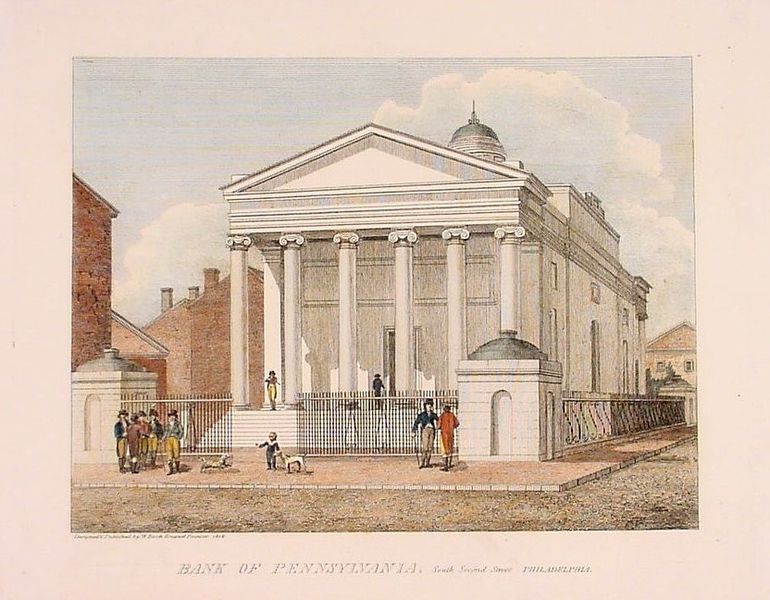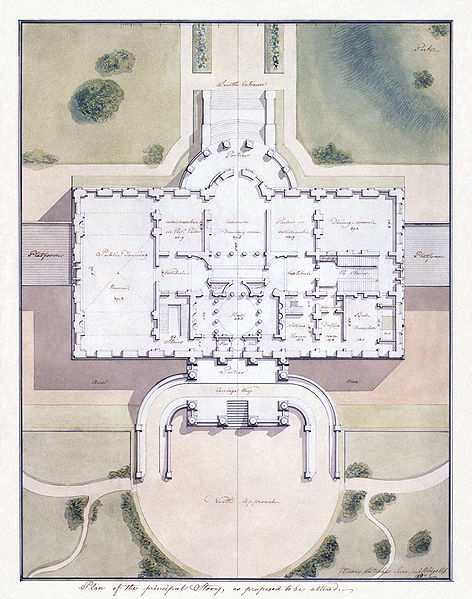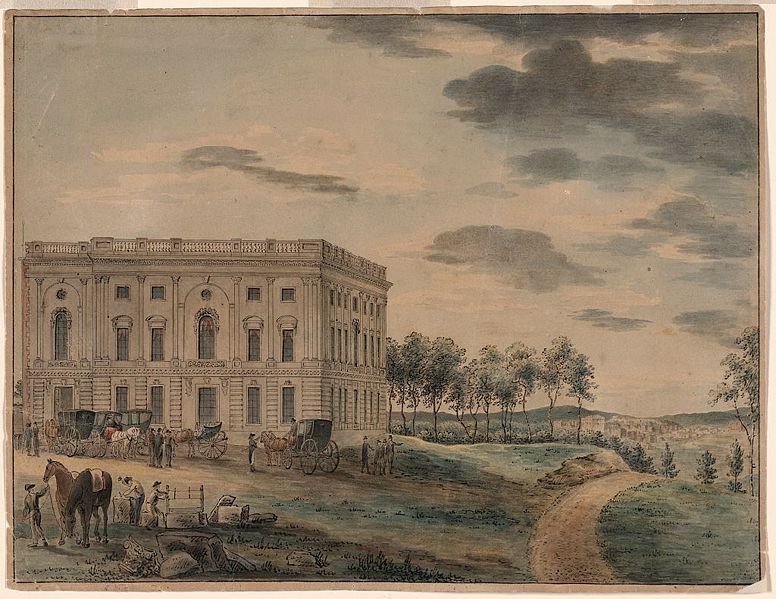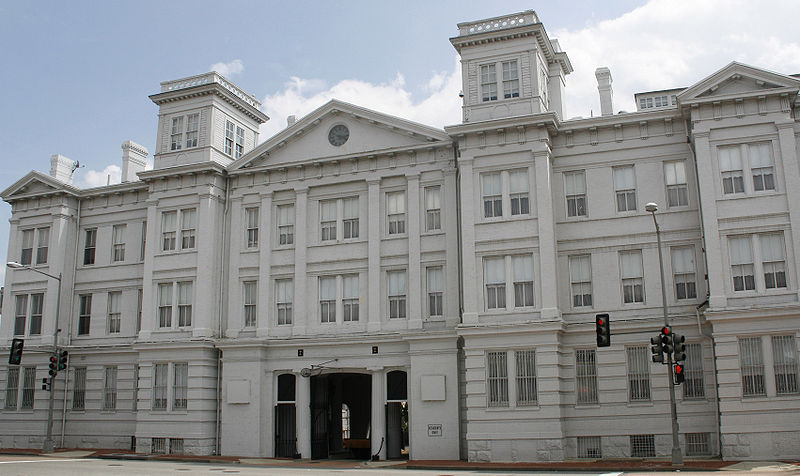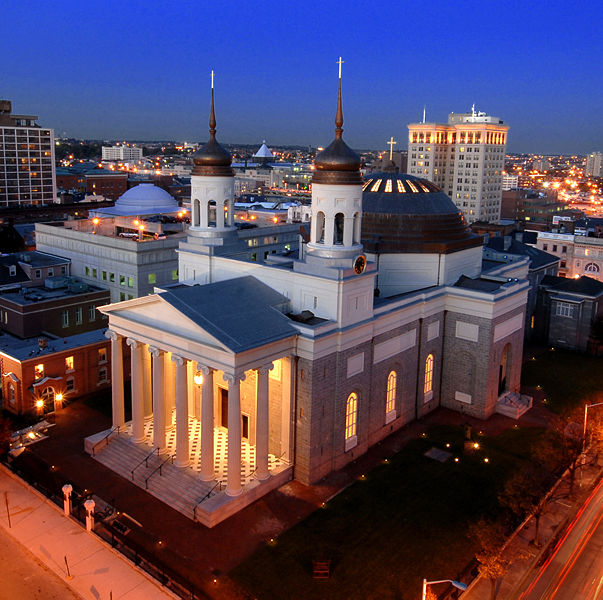<Back to Index>
- Physician Santiago Ramón y Cajal, 1852
- Architect Benjamin Henry Boneval Latrobe, 1764
- General and High Commissioner of Palestine Sir Alan Gordon Cunningham, 1887
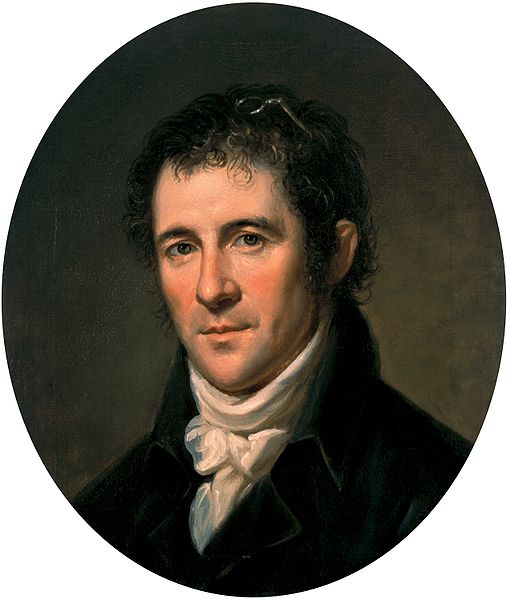
Benjamin Henry Boneval Latrobe (May 1, 1764 – September 3, 1820) was a British-born American architect best known for his design of the United States Capitol, as well as his design of the Baltimore Basilica, the first Catholic Cathedral built in the United States. Latrobe came to the United States in 1796, settling first in Virginia and then relocating to Philadelphia where he set up his practice. In 1803, he was hired as Surveyor of the Public Buildings of the United States, and spent much of the next fourteen years working on projects in Washington, D.C. Later in his life, Latrobe worked on a waterworks project in New Orleans, where he died in 1820 from yellow fever. He has been called the "Father of American Architecture".
Benjamin Henry Latrobe was born in 1764 at the Fulneck Moravian Settlement, near Pudsey in West Yorkshire, England, to Reverend Benjamin Latrobe and Anna Margaretta Antes. His mother was born in the American colony of Pennsylvania to a wealthy landowner, but was sent by her father to England to attend a Moravian school at Fulneck. Latrobe's father was responsible for all Moravian schools and establishments in Britain, and had an extensive circle of friends in the higher ranks of society. His father stressed the importance of education and scholarship and the value of social exchange, while his mother instilled curiosity and interest in America. From a young age, Latrobe enjoyed drawing landscapes and buildings. In 1776, at the age of 12, Latrobe was sent away to the Moravian School at Niesky in Silesia near the border of Saxony and Prussia. At age 18, Latrobe spent several months traveling around Germany, and then he joined the Prussian army, where he became close friends with a distinguished officer in the army of the United States. Latrobe may have served in the Austrian army, and suffered some injuries or illness. After recovering, he embarked on a continental Grand Tour, visiting eastern Saxony, Paris, Italy, and other places. Through his education and travels, Latrobe mastered German, French, Greek, and Latin, had advanced ability in Italian and Spanish, and had knowledge of Hebrew.
When Latrobe returned to England in 1784, he entered apprenticeship under John Smeaton, an engineer known for designing Eddystone Lighthouse. Then in 1787 (or 1788), he worked as an apprentice with neoclassical architect S.P. Cockerell, serving for a brief time before leaving to practice the profession. In 1790, Latrobe was hired as Surveyor of the Public Offices in London, possibly a cover for work for the embryonic Secret Service, and started his own private architectural practice in 1791. Latrobe was commissioned in 1792 to design Hammerwood Park, near East Grinstead in Sussex, which was his first independent work, and he designed nearby Ashdown House in 1793. Latrobe was involved in the construction of the Basingstoke Canal in Surrey, along with engineers John Smeaton and William Jessop. In spring 1793, Latrobe was hired to plan improvements to the River Blackwater from Maldon to Beeleigh, so that the port of Maldon could compete with the Chelmer and Blackwater Navigation, which bypassed the town. The project lasted into early 1795, when his scheme was not approved by Parliament. Latrobe had problems getting payment for his work on the project.
In
February 1790, Latrobe married Lydia Sellon, and they lived a busy
social life in London. The couple had a daughter (Lydia Sellon Latrobe)
and son (Henry Sellon Latrobe), before she died in November 1793 during
childbirth of a third child. Lydia
had inherited her father's wealth, which in turn was to be left to the
children through a trust with the children's uncles; The inheritance
ended up never going to the children. In
1795, after bankruptcy and his wife's death, Latrobe suffered a severe
nervous breakdown and decided to emigrate to America, departing on
November 25 aboard the Eliza. Later
in America Latrobe was known for his series of topological and
landscape watercolours and the series started with a view of the White
Cliffs of the south coast of England viewed from the Eliza. However, this was preceded by a watercolour of East Grinstead dated Sept 8th 1795. Latrobe arrived in Norfolk, Virginia in
mid-March 1796 after a harrowing four month journey aboard the poorly
managed ship, plagued with food shortages and near starvation. Latrobe initially spent time in Norfolk, where he designed the William Pennock House, then set out for Richmond, Virginia, in April 1796. Soon after arriving in Virginia, Latrobe became friends with Bushrod Washington, President George Washington's nephew, along with Edmund Randolph and other notable figures. Through Bushrod Washington, Latrobe was able to pay a visit to Mount Vernon to meet with the President in the summer of 1796. Latrobe's first major project in the United States was the State Penitentiary in Richmond, which was commissioned in 1797. The penitentiary included many innovative ideas in penal reform, espoused by Thomas Jefferson and other figures, including cells arranged in a semicircle (similar but not identical to Jeremy Bentham's panopticon) that allowed for easy surveillance, as well as improved living conditions for sanitation and ventilation. He also pioneered the use of solitary confinement in the Richmond penitentiary. While in Virginia, Latrobe worked on the Green Spring mansion near Williamsburg, which had been built by Governor Sir William Berkeley in the 1600s, but fell into disrepair after the American Revolutionary War. He also made drawings for a number of houses that were not built, including the Mill Hill plantation house near Richmond. After
spending a year in Virginia, the novelty of being in a new place wore
off, and Latrobe was lonely and restless in Virginia. Giambattista Scandella, a friend, suggested Philadelphia as an ideal location for him. In April 1798, Latrobe visited Philadelphia for the first time, meeting with Bank of Pennsylvania president
Samuel J. Fox, and presented a design for a new bank building. At the
time, the political climate in Philadelphia was quite different than
Virginia, with a strong division between the Federalists and Jefferson's Democratic-Republican Party, along with anti-French sentiment. Thus, the city was not entirely welcoming for Latrobe. On his way to Philadelphia, Latrobe passed through Washington, D.C., where he met with William Thornton and viewed the United States Capitol for the first time. He stopped by again on his way back to Richmond. Latrobe
remained in Richmond, Virginia, until November 1798 when his design was
selected for the Bank of Pennsylvania. He moved to Philadelphia, so that he could supervise the construction, though he continued to do occasional projects for clients in Virginia. Upon arriving in Philadelphia, Latrobe's two friends, Scandella and Volney, had left due to concerns regarding the Alien and Sedition Acts, but Latrobe made friends with some of their acquaintances at the American Philosophical Society.
Latrobe submitted several papers to the society, on his geology and
natural history observations, and became a member of the society. With
his charming personality, Latrobe quickly made other friends among the
influential financial and business families in Philadelphia, and became
close friends with Nicholas Roosevelt, a talented steam-engine builder who would help Latrobe in his waterworks projects. Latrobe's first major project in Philadelphia was to design the Bank of Pennsylvania, which was the first example of Greek Revival architecture in the United States. The Bank of Pennsylvania building was since demolished in 1870. This commission is what convinced him to set up his practice in Philadelphia, where he developed his reputation. Latrobe was also hired to design the Fairmount Water Works in Philadelphia. The Pump House, located at Center Square, was designed by Latrobe in a Greek Revival style. Following his work on the Philadelphia water works project, Latrobe worked as an engineer of the Chesapeake and Delaware Canal. In addition to Greek Revival designs, Latrobe also used Gothic Revival designs in many of his works, including the 1799 design of Sedgeley, a country mansion in Philadelphia. The
Gothic Revival style was also used in Latrobe's design of the
Philadelphia Bank building, which was built in 1807 and demolished in
1836. As a young architect, Robert Mills worked as an assistant with Latrobe from 1803 until 1808 when he set up his own practice. While in Philadelphia, Latrobe married Mary Elizabeth Hazlehurst in 1800. In the United States, Latrobe quickly achieved eminence as the first professional architect working in the country. Latrobe was a friend of Thomas Jefferson and likely influenced Jefferson's design for the University of Virginia; he was Aaron Burr's preferred architect. He knew many of the principal people of his time, including Jefferson and James Monroe, as well as New Orleans architect and pirate, Barthelemy Lafon. Latrobe's illustrated journals from his wide travels are a record of the young United States. Latrobe trained William Strickland in the art of architecture as there were no formal architecture schools in the United States at that time. In 1803, Latrobe was hired as surveyor of the Public Buildings of the United States, and superintendent of construction, to work on the United States Capitol. Latrobe was tasked to work with plans designed by William Thornton and construction work already underway. Latrobe
criticized the work done up to that point, and characterized it as
"faulty construction" in an 1803 letter to Vice President Aaron Burr. Nonetheless, President Thomas Jefferson insisted that Latrobe follow Thornton's design for the Capitol. In June 1812, construction in the capital came to a halt with the outbreak of the War of 1812 and the failure of the First Bank of the United States. During the war, Latrobe relocated to Pittsburgh, and returned to Washington in 1815, as Architect of the Capitol,
charged with responsibility of rebuilding the Capitol after it was
destroyed in the war. Latrobe was given more freedom in rebuilding the
Capitol, to apply his own design elements for the interior. By 1817, Latrobe had provided President James Monroe with complete drawings for the entire building. He
resigned as Architect of the Capitol on November 20, 1817. Without this
major commission, Latrobe faced difficulties and was forced into
bankruptcy. Latrobe left Washington, for Baltimore in January 1818. Latrobe's major work was overseeing construction of the United States Capitol, but he also was responsible for numerous other projects in Washington. In 1804, became chief engineer in the United States Navy. As chief surveyor, Latrobe was responsible for the Washington Canal. Latrobe
faced bureaucratic hurdles in moving forward with the canal, with the
Directors of the Company rejecting his request for stone locks. Instead, the canal was built with wooden locks which were subsequently destroyed in a heavy storm in 1811. Latrobe also designed the main gate of the Washington Navy Yard. Latrobe
worked on other transportation projects in Washington, D.C., including
the Washington & Alexandria Turnpike which connected Washington with Alexandria, as well as a road connecting with Frederick, Maryland, and a third road, the Columbia Turnpike going through Bladensburg to Baltimore. Latrobe also provided consulting on the construction of the Washington Bridge across the Potomac River in a way that would not impede navigation and commerce to Georgetown. Benjamin Latrobe was responsible for several other projects located around Lafayette Square, including St. John's Episcopal Church, Decatur House, and the White House porticos. Private homes designed by Latrobe include commissions by John P. Van Ness and Peter Casanove. Through
much of Latrobe's time in Washington, he remained involved to some
extent with his private practice and other projects in Philadelphia and
elsewhere. His clerk of works, John Lenthal, often urged Latrobe to
spend more time in Washington.
Latrobe
left Washington with pessimism, with the city's design contradicting
many of his ideals. Latrobe disliked the Baroque-style plan for the
city, and other aspects of L'Enfant's plan, and resented having to conform to Thornton's plans for the Capitol Building. One
of the greatest problems with the overall city plan, in the view of
Latrobe, was its vast interior distances. Latrobe considered the
Washington Canal as a key factor that, if successful, could help
alleviate this issue. Latrobe also had concerns about the city's economic potential. He argued for constructing a road connecting Washington with Frederick to the northwest to enhance economic commerce through Washington. Latrobe saw great potential for growth in New Orleans, situated at the mouth of the Mississippi River, with the advent of the steamboat and great interest in steamboat technology. Latrobe's first project in New Orleans was the New Orleans Custom House, built in 1807 under supervision of Robert Alexander. In 1810, Latrobe sent his son, Henry Sellon Boneval Latrobe,
to New Orleans to present a plan for a waterworks system before the New
Orleans City Council. Latrobe's plan for the New Orleans waterworks
system was based on that of Philadelphia, which he earlier designed.
The system in Philadelphia was created as a response to yellow fever epidemics affecting the city. Latrobe's system utilized steam pumps to move water from the Schuylkill River to
a reservoir, located upstream, so that gravity could be used to
transmit the water from there to residents in the city. The New Orleans
waterworks project was also designed to desalt water, using
steam-powered pumps. While in New Orleans, Latrobe's son participated
in battles during the War of 1812, and took on projects including
building a lighthouse, New Orleans' Charity Hospital, and the French
Opera House. New
Orleans agreed to commission the waterworks project in 1811, though
Latrobe was not ready to take on the project immediately, and faced
financial problems in securing enough investors for the project.
Latrobe's work on the United States Capitol was completed shortly
before the War of 1812 started,
ending his source of steady income. During the war, Latrobe
unsuccessfully tried several wartime schemes to make money, including
some steamboat projects. In 1814, Latrobe partnered with Robert Fulton in a steamship venture based at Pittsburgh. While in Pittsburgh, Latrobe designed and built a theater for the Circus of Pepin and Breschard. After
the United States Capitol and White House were burned during the war,
Latrobe remained in Washington, D.C. to help with rebuilding, and
Latrobe's son took on much of the work for waterworks project. In
1818, Latrobe worked on projects in Baltimore, including the Baltimore
Exchange, with hopes of generating more financial capital to use for
the waterworks project. Latrobe was earlier commissioned by John Carroll to build the first Roman Catholic Cathedral in the United States of America. Construction of the Baltimore Basilica was
begun in 1806, and finally completed in 1821, after financial setbacks
interrupted the building of the Cathedral for a number of years.
Latrobe completed the Baltimore Exchange project in 1818, and left for
New Orleans in December 1818, arriving on January 10, 1819. Latrobe
initially stayed at a hotel on Jackson Square.
Latrobe faced further delays with the New Orleans waterworks project,
trying to get an engine built for the project, which he finally
achieved in 1819. The process of designing and constructing the
waterworks system in New Orleans spanned eleven years. In addition to
the waterworks project, Latrobe designed the central tower of the St. Louis Cathedral, which was his last architectural project. Latrobe died in 1820 from yellow fever, while working in New Orleans on the waterworks project. He was buried in Saint Louis Cemetery in New Orleans, where his son, Henry, was buried three years earlier after also dying from yellow fever.
